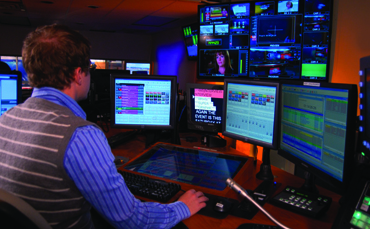Newsroom Graphics Tie It All Together

Accuweather’s StoryTeller is a 1080p HD (Samsung or NEC) interactive, multitouch touchscreen system combined with a portfolio of 14 apps.
HAMILTON, N.J.—For today’s news staff, it’s increasingly vital to harness social media content to create an engaging, hyperlocal audience experience on TV newscasts as well as the second screen experience. This social TV trend impacts the creation of broadcast television graphics for news, sports, and other live shows.
On-air graphics are not only being filled with timely information from the news desk, data services, social media and other sources, they need to be repurposed for delivery to the station’s website, social media accounts, online and mobile services.
It’s equally important for news organizations to have a strong, active presence in the social sphere—including Twitter and Facebook—to attract viewers to upcoming newscasts and promote their channel as a source for breaking news. Finding ways to automate the repurposing of graphics for multiple platforms is critical since many news operations would like to manage the additional workload without adding staff or operating costs.
MULTIPLE FORMATS
“One of the challenges we face as an industry is the sheer number of formats required for file-based workflows and multi-format distribution to online, mobile, and social media outlets,” said Brian Olson, director of graphics marketing and product management for Ross Video.
The Ross newsroom workflow has several systems that talk to each other to repurpose graphics and video. For example, the company’s Inception social media editor has tools to grab and filter social media content, which it then sends to Ross’s Xpression live graphics system. If journalists or producers want to repurpose a news graphic or segment from live news for online distribution, they can tag the in and out points and Ross QuickTurn controls a Digital Rapids encoder, which converts it to the appropriate formats.
Get the TV Tech Newsletter
The professional video industry's #1 source for news, trends and product and tech information. Sign up below.
With the strategic use of tags in the news workflow, including our Ross OverDrive production automation system, QuickTurn can automatically monitor the output of the production control room to direct the tagged content to the encoder for delivery to the Web or mobile services. QuickTurn can send the video any way the user requires, including a clean feed, one with graphics overlaid, or just the graphics,” said Allan Pepper, marketing product manager for Over- Drive, Inception and QuickTurn. “Also in the newsroom workflow, Inception monitors everything that’s happening on social media, including what’s trending, and then captures content that meets user-defined filters. It also gives news creators the final say as to what social content is chosen.”
TELLING STORIES
When competing with 24-hour news networks, local call-letter stations need costeffective, simple-to-use presentation tools that can give them that big network look. AccuWeather’s StoryTeller is a 1080p HD interactive, multitouch touchscreen system combined with a portfolio of 14 apps, backed by 24/7 service and support. New apps, which AccuWeather has in development, are added on a quarterly basis.
WAGA-TV Fox 5 in Atlanta decided to use Storyteller to launch an 11 p.m. newscast that would have a contemporary, unique, yet cost-effective graphical look, and it’s now used throughout the entire show.
“StoryTeller regularly provides fresh data and content to fill the touchscreen, but stations can also input their own text, pictures, HD video from up to four live sources like traffic or weather cams, as well as local news footage into the templates,” said Ryan Ayres, vice president of display services for Accu-Weather in State College, Pa.
The elections app rivals network coverage, with interactive maps that readily display detailed information about congressional districts, candidates, and electoral issues. It also integrates with real-time data feeds containing timely election results. Social media from Twitter and Facebook can also be filtered by geography, topic, or other criteria, edited and then quickly put into the social media app’s templates for live display. And any StoryTeller displays, such as current traffic conditions, can also be output to the station’s website, social media, or other online and mobile outlets.
Gray Television Group of Atlanta has standardized on the Vizrt graphics workflow throughout its group of 36 TV affiliates.
COMBINING SDI AND IP

Responding to customer requests for IP streaming capabilities, Orad designed its new HDVG4 rendering platform to handle both SDI signals and IP streaming I/Os. “There’s a clear trend that social TV is here to stay, and that we will continue to see a much closer relationship between the first and second screen,” said Ofir Benovici, vice president of marketing for Orad.
“While you can simultaneously output SDI and IP streams from the HDVG4, broadcasters can output identical program content via SDI and IP, or different content depending on whatever creative, marketing, branding, or technical needs they may have,” Benovici said.
While crawls and tickers work well on TV, broadcasters would leave that element out of the mobile version since viewers can’t read them due to the very small screens. Even if the same content is going to the first and second screens, broadcasters may want the streams to have different looks or branding elements, and the HDVG4 lets them have that control.
IP streaming on the HDVG4 makes it easier to distribute TV content to websites and mobile devices. It also provides the means to integrate user-generated content from social media into traditional graphics. “Graphical elements will increasingly move between the first and second screen in a circular path,” Benovici said. “Broadcasters need to be able to distribute content efficiently between the first and second screen to remain relevant.”
REDUCING BOTTLENECKS
Social TV is a vital component of the Vizrt graphics workflow, which supports content distribution to air, online, and mobile devices. One core element to this workflow is the Viz Engine, a real-time HD/SD video and 3D graphics compositing and rendering engine with IP streaming capabilities. Another is the Viz Media Engine, a media asset management system that enables an end-to-end workflow from acquisition to editing, graphics branding and playout. Among its capabilities, Viz Media Engine automatically encodes live video from high-res video to any format at speeds faster than real-time for delivery to online and mobile devices.
With its partnership with Social TV leader never.no, Vizrt’s workflow enables broadcasters to dovetail social media buzz into their live broadcast fare, including on-air graphics, and deliver it to portable devices and social platforms.
“When you’re dealing with multiple platforms for managing video and graphics, the biggest bottleneck is getting all the systems to communicate and transfer content efficiently,” said Petter Ole Jakobsen, Vizrt’s CTO. “This typically requires multiple moving or transcoding of files and then distributing to the various output channels. With Vizrt, all content stays in one spot. Nothing is merged or burned until the moment you go to air. So it’s possible to have breaking news on-air, online, and on mobile devices simultaneously while giving the best possible viewing experience to the end user.”
Gray Television Group of Atlanta has standardized on the Vizrt graphics workflow throughout its group of 36 TV affiliates. Gray has adopted a unique centralized hub model where artists in one location create graphics templates for the entire group. While the stations are free to fill and use these templates in their daily newscasts, the centralized design helps Gray TV maintain consistent branding across its group.
‘RESKINNING’ GRAPHICS
ChyronHego’s product line has been evolving to enable solutions for efficient repurposing of news and sports graphics for multiple platforms. “Our goal is to give news creators the means to incorporate social media data into their live graphics as well as repurpose broadcast graphics for online, mobile, and social media delivery,” said Jim Martinolich, vice president of integration for the Melville, N.Y.-based company. “The real challenge is to come up with workflows that let them fulfill these new graphics demands with current manpower levels.”
One example of how an efficient workflow can be beneficial is the “reskinning” of graphics. If the graphics for the 6 p.m. newscast are template-based, and the station wants to use them on its website “our tools allow them to switch the template set and render new graphics,” Martinolich said. “Any data, real-time feeds, video or other elements the original templates contained will automatically populate the new online graphics.”
The new graphics can either preserve the on-air look or assume an entirely new channel branding. “The point is to find the right workflow to automate and streamline your news workflow wherever possible,” Martinolich added.
ChyronHego, a result from the March 2013 merger of Chyron Corp. and Swedenbased graphics company Hego Group, has a varied product line, including Camio, the newsroom MOS gateway device that interfaces Chyron graphics systems to newsroom systems like iNews, ENPS, Dalet, and others.
Camio can be used with Chyron HyperX3.1, which creates live graphics, or Chyron MediaMaker, a file-based graphics tool that facilitates multiplatform distribution of broadcast graphics. Chyron Shout interfaces with third-party social media aggregation software to create on-air graphics displays, and Chyron Engage is instrumental in creating compelling social media, Social TV and second screen experiences.
KEEP IT SIMPLE
When stations need to multipurpose live graphics or other elements for online, social media, or mobile distribution, having an integrated, end-to-end workflow is essential to getting the task done as quickly and efficiently as possible.
“All of your systems, including the newsroom control system, live graphics, asset management, and publishing platform, have to work together seamlessly,” said Jim Frantzreb, Avid’s segment director for broadcast. “Repurposing graphics, or any news elements, for multiplatform distribution should also require the least number of steps possible, with much of the work happening automatically as a background process.
“Particularly today, as broadcast and social TV converge, the biggest challenge is having production islands that are not fully integrated into a unified workflow,” he added. “This causes bottlenecks that make it harder to create graphics once, and then reuse or distribute them in multiple ways.”
The Avid newsroom workflow integrates many systems including: Avid Motion Graphics, a family of 2D/3D-animated CG’s with sophisticated capabilities from graphics creation to controlled playout; the iNEWS newsroom management system for developing news stories and rundowns for multiple platforms; and Avid Interplay Production and Interplay MAM for intelligent media asset/ metadata management.
Avid recently introduced Interplay Pulse, an automated solution that streamlines publication to online, social, and mobile platforms directly from iNEWS and/or Interplay Production. “The entire graphics, asset and metadata workflow—including creation, transcoding, and delivery—can be orchestrated from a single user interface for a consistent brand and audience experience across platforms,” Frantzreb said.

